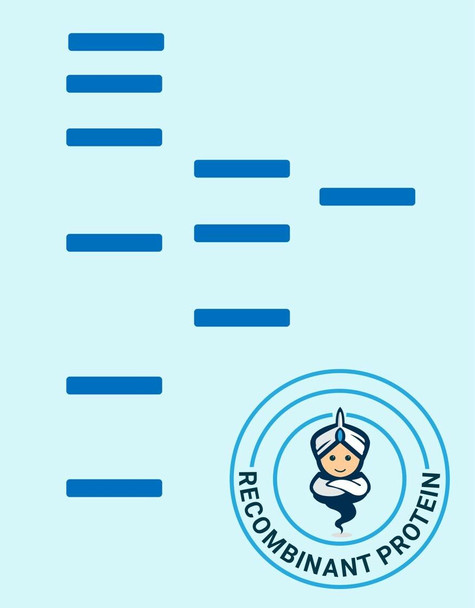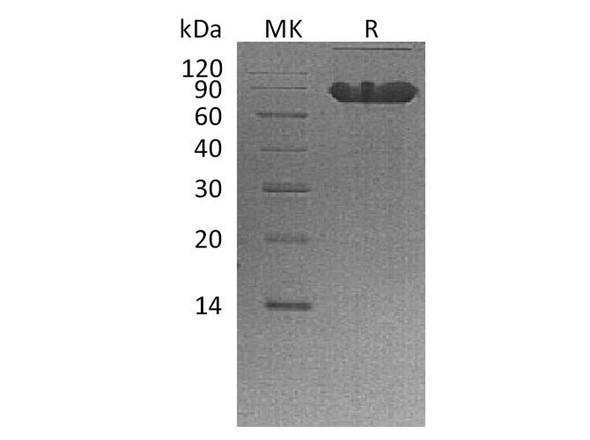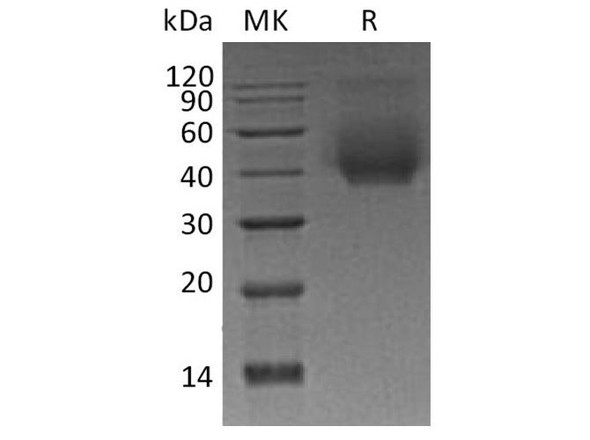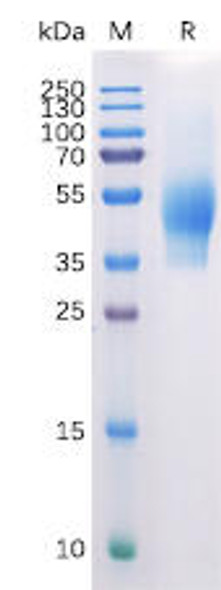CD Antigens Recombinant Proteins
Human CD44 Recombinant Protein (RPPB3038)
- SKU:
- RPPB3038
- Product Type:
- Recombinant Protein
- Species:
- Human
- Uniprot:
- P16070
- Research Area:
- CD Antigens
Description
| Product Name: | Human CD44 Recombinant Protein |
| Product Code: | RPPB3038 |
| Size: | 5µg |
| Species: | Human |
| Target: | CD44 |
| Synonyms: | CD44 Molecule (Indian Blood Group), Hematopoietic Cell E- And L-Selectin Ligand, GP90 Lymphocyte Homing/Adhesion Receptor, Chondroitin Sulfate Proteoglycan 8, Extracellular Matrix Receptor III, Heparan Sulfate Proteoglycan, Phagocytic Glycoprotein 1, Hyaluronate Receptor, Hermes Antigen, ECMR-III, HUTCH-I, Epican, CDW44, MDU2, MDU3, MIC4, LHR, CD44 Antigen (Homing Function And Indian Blood Group System),Homing Function And Indian Blood Group System, Cell Surface Glycoprotein CD44, Phagocytic Glycoprotein I, Soluble CD44, CSPG8, HCELL, PGP-1, PGP-I, MC56, Pgp1, IN, CD44 . |
| Source: | Sf9 Insect cells |
| Physical Appearance: | Sterile filtered colorless solution. |
| Formulation: | CD44 protein solution (0.25mg/ml) contains 10% glycerol & Phosphate buffered saline (pH7.4). |
| Stability: | Store at 4°C if entire vial will be used within 2-4 weeks. Store, frozen at -20°C for longer periods of time. For long term storage it is recommended to add a carrier protein (0.1% HSA or BSA).Avoid multiple freeze-thaw cycles. |
| Purity: | Greater than 95.0% as determined by SDS-PAGE. |
| Amino Acid Sequence: | QIDLNITCRF AGVFHVEKNG RYSISRTEAA DLCKAFNSTL PTMAQMEKAL SIGFETCRYG FIEGHVVIPR IHPNSICAAN NTGVYILTSN TSQYDTYCFN ASAPPEEDCT SVTDLPNAFD GPITITIVNR DGTRYVQKGE YRTNPEDIYP SNPTDDDVSS GSSSERSSTS GGYIFYTFST VHPIPDEDSP WITDSTDRIP LEPKSCDKTH TCPPCPAPEL LGGPSVFLFP PKPKDTLMIS RTPEVTCVVV DVSHEDPEVK FNWYVDGVEV HNAKTKPREE QYNSTYRVVS VLTVLHQDWL NGKEYKCKVS NKALPAPIEK TISKAKGQPR EPQVYTLPPS RDELTKNQVS LTCLVKGFYP�SDIAVEWESN GQPENNYKTT PPVLDSDGSF FLYSKLTVDK SRWQQGNVFS CSVMHEALHN HYTQKSLSLS PGKHHHHHH |
CD44 is a cell-surface glycoprotein that plays a role in cell-cell interactions, cell adhesion and migration. CD44 is a receptor for hyaluronic acid and also interacts with other ligands, such as osteopontin, collagens, and matrix metalloproteinases. CD44 participates in a wide variety of cellular functions such as lymphocyte activation, recirculation and homing, hematopoiesis, and tumor metastasis.
CD44 produced in Sf9 Baculovirus cells is a single, glycosylated polypeptide chain (21-220 a.a.) and fused to a 239 aa hIgG-His-tag at C-terminus containing a total of 439 amino acids and having a molecular mass of 49kDa.CD44 shows multiple bands between 57-70kDa on SDS-PAGE, reducing conditions and purified by proprietary chromatographic techniques.
| UniProt Protein Function: | CD44: Receptor for hyaluronic acid (HA). Mediates cell-cell and cell-matrix interactions through its affinity for HA, and possibly also through its affinity for other ligands such as osteopontin, collagens, and matrix metalloproteinases (MMPs). Adhesion with HA plays an important role in cell migration, tumor growth and progression. Also involved in lymphocyte activation, recirculation and homing, and in hematopoiesis. Altered expression or dysfunction causes numerous pathogenic phenotypes. Great protein heterogeneity due to numerous alternative splicing and post-translational modification events. Interacts with PKN2. Interacts with HA, as well as other glycosaminoglycans, collagen, laminin, and fibronectin via its N-terminal segment. Interacts with ANK, the ERM proteins (VIL2, RDX and MSN), and NF2 via its C-terminal segment. Isoform 10 (epithelial isoform) is expressed by cells of epithelium and highly expressed by carcinomas. Expression is repressed in neuroblastoma cells. 19 isoforms of the human protein are produced by alternative splicing. |
| UniProt Protein Details: | Protein type:Cell adhesion; Motility/polarity/chemotaxis; Membrane protein, integral; Receptor, misc. Chromosomal Location of Human Ortholog: 11p13 Cellular Component: Golgi apparatus; focal adhesion; cell surface; basolateral plasma membrane; integral to plasma membrane; cytoplasm; plasma membrane; external side of plasma membrane Molecular Function:collagen binding; hematopoietin/interferon-class (D200-domain) cytokine receptor activity; protein binding; hyaluronic acid binding; hyalurononglucosaminidase activity Biological Process: extracellular matrix organization and biogenesis; Wnt receptor signaling pathway; positive regulation of heterotypic cell-cell adhesion; glycosaminoglycan metabolic process; cytokine and chemokine mediated signaling pathway; cell-matrix adhesion; pathogenesis; negative regulation of caspase activity; positive regulation of peptidyl-serine phosphorylation; hyaluronan catabolic process; extracellular matrix disassembly; negative regulation of DNA damage response, signal transduction by p53 class mediator; cell-cell adhesion; positive regulation of peptidyl-tyrosine phosphorylation; ureteric bud branching; cartilage development; carbohydrate metabolic process; blood coagulation; leukocyte migration; healing during inflammatory response; hyaluronan metabolic process; negative regulation of apoptosis Disease: Blood Group, Indian System |
| NCBI Summary: | The protein encoded by this gene is a cell-surface glycoprotein involved in cell-cell interactions, cell adhesion and migration. It is a receptor for hyaluronic acid (HA) and can also interact with other ligands, such as osteopontin, collagens, and matrix metalloproteinases (MMPs). This protein participates in a wide variety of cellular functions including lymphocyte activation, recirculation and homing, hematopoiesis, and tumor metastasis. Transcripts for this gene undergo complex alternative splicing that results in many functionally distinct isoforms, however, the full length nature of some of these variants has not been determined. Alternative splicing is the basis for the structural and functional diversity of this protein, and may be related to tumor metastasis. [provided by RefSeq, Jul 2008] |
| UniProt Code: | P16070 |
| NCBI GenInfo Identifier: | 308153615 |
| NCBI Gene ID: | 960 |
| NCBI Accession: | P16070.3 |
| UniProt Secondary Accession: | P16070,O95370, P22511, Q04858, Q13419, Q13957, Q13958 Q13959, A5YRN9, B6EAT9, D3DR12, D3DR13, |
| UniProt Related Accession: | P16070 |
| Molecular Weight: | 81,538 Da |
| NCBI Full Name: | CD44 antigen |
| NCBI Synonym Full Names: | CD44 molecule (Indian blood group) |
| NCBI Official Symbol: | CD44�� |
| NCBI Official Synonym Symbols: | IN; LHR; MC56; MDU2; MDU3; MIC4; Pgp1; CDW44; CSPG8; HCELL; HUTCH-I; ECMR-III�� |
| NCBI Protein Information: | CD44 antigen; epican; Hermes antigen; hyaluronate receptor; phagocytic glycoprotein 1; heparan sulfate proteoglycan; cell surface glycoprotein CD44; extracellular matrix receptor III; chondroitin sulfate proteoglycan 8; GP90 lymphocyte homing/adhesion receptor; hematopoietic cell E- and L-selectin ligand; homing function and Indian blood group system |
| UniProt Protein Name: | CD44 antigen |
| UniProt Synonym Protein Names: | CDw44; Epican; Extracellular matrix receptor III; ECMR-III; GP90 lymphocyte homing/adhesion receptor; HUTCH-I; Heparan sulfate proteoglycan; Hermes antigen; Hyaluronate receptor; Phagocytic glycoprotein 1; PGP-1; Phagocytic glycoprotein I |
| Protein Family: | CD44 antigen |
| UniProt Gene Name: | CD44�� |
| UniProt Entry Name: | CD44_HUMAN |






